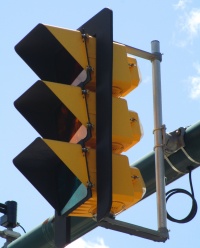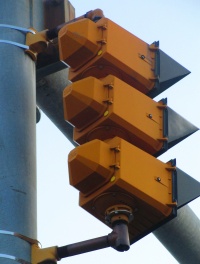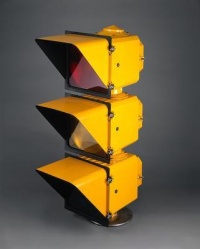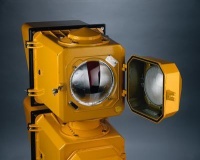Difference between revisions of "3M"
(→Signal Enlargers) |
(→M-131 Programmable Visibility Signal) |
||
| Line 35: | Line 35: | ||
--To Be Edited-- | --To Be Edited-- | ||
| + | |||
| + | A list of all of the known 3M M-131 ID numbers can be found [[3M_ID_Numbers|here]]. | ||
====M-131R Bimodal (Ball/Arrow) Signal==== | ====M-131R Bimodal (Ball/Arrow) Signal==== | ||
Revision as of 05:05, 1 January 2014
Some really random text about 3M's traffic division here. (Also, be sure to reference that they made a bi-modal, time-programmable sign, too!)
This page is a work in progress!
Contents
3M Brand
Overview
Past
Current
Products
Programmable Visibility Signals
Vehicle Signals (12")
M-123 Programmable Visibility Prototype Signal
Early version of the M-131. It is believed, at this time, that the first PV signal was identical to the well-known M-131 signal, with some refinements done to the casting when it was redubbed the M-131 and expanded in the product line. Most notably is the lack of visors and conical shaped rear bulb compartment.
M-131 Programmable Visibility Signal
Info I have saved on 3Ms, feel free to rip apart, correct, reword, whatever. -Pyth
3M, the same company that makes well-known everyday products such as Scotch tape, entered the traffic control industry in 1969 with High-Visibility signals. These lights were unlike any other at the time in both design and operation. They featured PAR-46 lamps in the back of the signal, with an opening back housing that had an auto-disconnect to prevent electrical shock. This light would shine through multiple layers, which helped prevent a condition known as the 'sun phantom effect', where a signal would appear to be lit in all 3 indications during sunrise or sunset. The unique signal build also offered 'programmable visibility', where a technician could mask off parts of the road the signal faced so only certain lanes or areas saw the signal indication, while masked off areas saw the signal as off or very very dimly lit. At a time before louvers, this was very helpful in congested or crammed areas where drivers could be confused or overwhelmed by the number of signals lit. This unique feature came at it's own cost, however. A 3-section M-131, the most common model, weighs in at around 65 pounds, whereas the average 3-section 12" head comes in at around 40 pounds. Also, as mentioned, the M-131 uses PAR-46 lamps, which have much shorter lives than the average signal bulbs, and cost considerably more each. The PAR-46 bulbs also get incredibly hot after being on for a while, which is an inconvenience for collectors and field technicians. McCain produces a near-identical line of High-Visiblity Signals as well, which are understood to cost less but weigh around 80 pounds per 3-section head. 3M stopped producing this line in 2007, due to decreasing orders. Many collectors like to have at least one of these signals due to their unusual design.
LED inserts are offered by third party manufacturers (link to Electrotech and whoever else made them), but they usually require the removal of the photocell dimming unit to ensure proper function.
--To Be Edited--
A list of all of the known 3M M-131 ID numbers can be found here.
M-131R Bimodal (Ball/Arrow) Signal
This was a regular '123 or '131 signal with the green ball lens replaced with a special prismatically (called "bimodal" by 3M) designed lens that would show either a ball or arrow based on your distance from the signal. Typically, cars far away would see a green ball, as they approached the view would change to an arrow. --To Be Edited--
M-133 Dual-Indication (Green/Yellow) Signal
This was a true bimodal section, as to how bimodal is typically used in this industry. This was a seperate section sold as an addon, preferrably to a M-131 signal. This section contained a single clear lens and a set of color filters. A rotissarie motor was housed in an extension off to the side of the signal and was responsible for running a set of baffles that would change the filter from green to yellow. Typically this was only used with arrows and saved some of the expense and most of the space of adding a full two sections to an existing signal. --To Be Edited--
Pedestrian Signals (12")
M-131 P.V. Pedestrian Signal
3M also marketed the M-131 signal with "Don't Walk" and "Walk" lenses as a pedestrian signal. In later years they would also offer the international U.S.-spec Man and Hand lenses.
M-132 Dynamic Pedestrian Signal
Same as the M-133 Arrow signal, but using a Don't Walk lens and selective lighting to control if a red DONT WALK message was seen or a blue WALK message.
Signal Adapters/Converters
Vehicle Signal Adapter (8")
SA-130A (Adapter attachment)
These were long extension tubes installed in place of the lense and visor of any 8" signal (a necessity as these were sold as retrofit kits and 3M never produced an 8" signal of their own). They were mini versions of the optical setup of the M-131 signal bringing the same features and capabilities to existing signals, possibly saving a city costly conversions to 12" signal heads. --To Be Edited--
Vehicle Signal Converter (12")
M-150 (Lens/Reflector System)
The 3M M-150 Lens & Reflector System was created by 3M to give regular 12" traffic signals some of the M-131 signal's features.
The M-150 is installed almost exactly like a modern LED module. The signal's original socket, reflectors & lens would be removed; the M-150 unit has all of those in it. The wires that went to the original socket are rewired to the back of the unit. It is then fitted into the door just like the lens was.
The front extended part is a dual diffusing lens (dome-shaped on the inside, cylinder-shaped on the outside). These inserts offered the High Visibility feature of the M-131 signal (having a fuller, brighter & clearer indication, compared to that of a typical incandescent signal). It did not have the Programmable Visibility feature, because the masking would have to be applied too close to the light source to have the proper effect.
DISCONTINUATION:
3M discontinued these early on, because they caused an effect called 'sun phantoming', which occurs when the sun shines through the lens and is reflected back out by the reflector, making it look like all indications are lit.

PC-310 Signal Intensity Control
Nothing is known about this device.
Signal Enlargers
Signal enlarges are attachments mounted on a signal door that expand to fit a larger lens. Around the early 60s, larger signal indications were becoming more popular because visibility was becoming a greater concern. Installing enlargers on a signal was cheaper and easier than replacing it.
3M made 3 lines of signal enlargers; for vehicle signals, round-lens pedestrian signals, and square-lens pedestrian signals. They were all reprimanded for not being built to 3M's strength & quality standards; they were made of thin, lightweight folded sheetmetal with many unsealsed slots on the corners and along the sides. They were mounted in the place of a signal's visor, using the exact same attachments.



Vehicle Signal to Vehicle Signal
These were made to convert the display of typical 8" signals to that of a 12" signal.
SA-812
Patented on December 17 1973, this enlarger unit converts a typical 8" signal indication to a 12" indication. The enlarger mounts where the visor would go on the signal's door. It is essentially a box that expands around an 8-inch lens to fit a door with a 12-inch lens.
The signal's original 8-inch lens is replaced with a glass diffusing lens. The enlarger is attached in the place of the visor using the visor's screws. It is octagon-shaped where it attaches to the door; as it extends outward, the slanted sides (which are triangle-shaped) become the corners of the square-shaped front. A square lens slides into the lens holder/front door of the unit, which has a 12" circular hole for the indication to shine through. The door then simply slides into place on the front of the enlarger.
With this setup, the light shines through the 8" lens, into the enlarger and out the 12" lens, generating a larger and more visible indication with the same amount of light and without having to replace the signal.
3M specifically noted that these enlargers would not fit Eagle Durasig signals or any TSI signals. They offered special clips needed when mounting on Crouse-Hinds signals.
The name of this product means "Signal Adaptor - 8 inch to 12 inch"
SA-810
If enlargers need to be used on two consecutive sections of a signal (for example, the 2 green indications on a 4-section R–Y–G–GA signal), there would not be enough space. The SA-812 12" enlarger extends slightly over both sections around it in order to... well, enlarge... and you would not be able to fit a second one beneath it.
That is what the SA-810 is for; it is designed specifically to fit under an SA-812. It is almost exactly the same as the SA-812, except that it bends down at the top (instead of up) to fit beneath and match the curvature of the other one. Because of the height limitation, the lens is only 10"x12". And due to that irregular size, they were only available with green left or right arrows. Horizontal arrows are the only indications that would be able to fit while remaining the correct size.
The name of this product means "Signal Adaptor - 8 inch to 10 inch"
Vehicle Signal to Pedestrian Signal
Though the 3M catalog specifically says these "are adapters to enlarge 8" vehicle signals to 12" pedestrian signals", they were most likely designed for round-lens WAIT-WALK pedestrian signals (which used the same housing as vehicle signals).
SA-812DW
This enlarger uses the same body as the SA-812 with the lens & door of a SA-912.
The name of this product means "Signal Adapter - 8 inch to 12 inch pedestrian, DONT WALK"
SA-810W
This enlarger uses the same body as the SA-810 with the lens & door of a SA-910.
The name of this product means "Signal Adapter - 8 inch to 12 inch pedestrian, WALK"

If you notice, this image has 2 mistakes; the dotted signal behind it is a vehicle signal (instead of a pedestrian signal), and the back of the enlarger has an octagon shape (instead of square).


The signal has since been removed.
Pedestrian Signal to Pedestrian Signal
These were made to convert the display of typical 9" pedestrian signals to that of a 12" pedestrian signal.
SA-912
This enlarger is for the DONT WALK section of a pedestrian signal. The SA-910 is for the WALK section.
The enlarger mounts where the visor would go on the signal's door. It is essentially a box that expands around a 9-inch lens to fit a door with a 12-inch lens.
The signal's original 9-inch lens is replaced with a clear or colored plastic diffusing lens. The enlarger is attached in the place of the visor using the visor's screws. It is square-shaped at both ends. A square DONT WALK plastic frensel lens with red 4½" lettering slides into the lens holder/front door of the unit, which acts as a frame for the lens. There is a lip around the inside edge of the door frame, to which the new visor attaches. The door then simply slides into place on the front of the enlarger.
With this setup, the light shines through the diffusing lens, into the enlarger and out the 12" lens, generating a larger and more visible indication with the same amount of light and without having to replace the pedestrian signal.
3M offered specific versions of these adaptors with slightly different attachments to fit Marbelite and Econolite pedestrian signals.
The name of this product means "Signal Adaptor - 9 inch to 12 inch"
SA-910
This enlarger is for the WALK section of a pedestrian signal. The SA-912 is for the DONT WALK section.
This enlarger section has a 10"x12" lens. It is smaller because it needs to fit beneath the SA-912 adaptor on a pedestrian signal. The SA-912 (DONT WALK), which is a full 12"x12", extends slightly over the WALK section. In order to match the curvature, the top of this adaptor bends downward, instead of upward like the SA-912. Other than that, they are exactly the same.
The DONT WALK indication needs to be largest because it has two lines of text, and the WALK indication only has one. In a normal signal, the DONT WALK and WALK lenses are the same size, and the WALK has blank space on the top and bottom. That extra space could be cut off and the WALK indication would remain the correct size, which is essentially what was done with these.
Like the SA-912, this adaptor is attached where the visor would go on a signal, using the visors screws. The original lens is replaced with a clear or colored plastic diffusing lens. The outer lens, a plastic frensel lens that says WALK in 4½" white lettering, is displayed on the front of the adaptor.
The name of this product means "Signal Adaptor - 9 inch to 10 inch"





